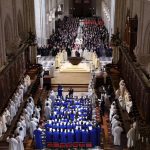In the heart of the Catholic Faith lies a paradox so profound it can only be understood through the eyes of faith: the juxtaposition of the agony of the Cross and the overwhelming joy of the Resurrection. For Catholics, Holy Week and Easter form the spiritual core of the liturgical year. It is in this sacred rhythm of death and resurrection, sorrow and rejoicing, that we come to understand not just Christ’s mission, but our own path to redemption.
The Terror and Tragedy of the Cross
Good Friday brings us face-to-face with suffering—raw, brutal, and unjust. The crucifixion of Jesus Christ is not merely a historical event; it is a divine drama of love and sacrifice. We see the sinless Son of God betrayed, mocked, scourged, and ultimately nailed to a cross. There is no beauty in this death by worldly standards. It is gruesome and humiliating—a punishment reserved for the worst of criminals.
The terror of the crucifixion is not only physical but deeply spiritual. Jesus cries out, “My God, my God, why have you forsaken me?” (Mt. 27:46). This is not a cry of despair, but a recitation of Psalm 22, a prophecy of the suffering Messiah. Still, it reveals the depth of Christ’s solidarity with humanity, even in its most abandoned state. In that moment, He bore the full weight of our sin, our pain, our darkness.
For Mary, His mother, and for His disciples, the Cross was devastating. Everything they hoped for seemed to crumble. How could this be the Messiah? The one who raised the dead, healed the sick, and preached the Kingdom of God was now lifeless on a tree. The sorrow pierced their hearts like a sword—especially Mary’s, as Simeon had foretold (Lk. 2:35).
The tragedy of the Cross reminds us that suffering is part of the human condition. But as Catholics, we do not believe that pain is meaningless. The crucifixion teaches us that God does not run from our suffering—He enters into it. He redeems it.
The Silence of Holy Saturday
Between the Cross and the Resurrection is a day often overlooked: Holy Saturday. This is the day of silence, the day the Church waits. The tomb is sealed. Christ is truly dead. It is a day that mirrors the experience of those who have lost hope, who sit in grief and confusion. It reminds us that, in our own lives, there are seasons where God seems silent.
Yet even in that silence, God is at work. The ancient tradition tells us that Christ descended to the dead, bringing light to those who had died in hope. Holy Saturday is a mysterious bridge—a quiet space between sorrow and joy, death and life.
The Joy of Easter Morning
Then, with the first light of dawn on Easter Sunday, everything changes. The tomb is empty. The stone is rolled away. The women who come to anoint Jesus’ body are greeted not by death, but by an angel proclaiming, “He is not here; he has risen” (Lk. 24:6).
The joy of Easter is not mere optimism. It is not simply a happy ending after a sad story. It is the fulfillment of God’s eternal promise. Christ’s resurrection is the definitive victory over death, sin, and Satan. For Catholics, the Resurrection is not just an event of the past—it is a living reality. Every Mass is a celebration of this Paschal Mystery: the death and resurrection of Christ made present in the Eucharist.
Easter joy is radiant. It is the kind of joy that transformed fearful disciples into bold proclaimers of the Gospel. It is the joy that carries martyrs through persecution, that fills monasteries with song, that brings tears to the eyes of penitents receiving mercy. It is the joy of knowing that love is stronger than death.
Living the Paschal Mystery
So what does this mean for us today?
The rhythm of Good Friday, Holy Saturday, and Easter Sunday is not confined to the liturgical calendar. It is the rhythm of our lives. We all experience Good Fridays—the unexpected diagnosis, the death of a loved one, the betrayal by a friend, the weight of our own failures. We all walk through Holy Saturdays—times of waiting, wondering, and silence.
But Easter is coming. Always.
As Catholics, we are called not to run from the Cross, but to embrace it, knowing that it is the path to new life. In baptism, we are united with Christ in His death and resurrection. This is not poetic language—it is a mystical truth. “If we have died with Him, we shall also live with Him” (Rom. 6:8).
A Joy Worth Sharing
The Resurrection compels us to share the Good News. It is too powerful, too life-changing to keep to ourselves. The same Jesus who broke the chains of death calls us to be witnesses of His mercy and love in a broken world.
This Easter season, may we carry the light of Christ into the dark places. May we console the grieving, uplift the weary, and stand with those who suffer, knowing that even in the darkest night, the dawn of Resurrection is near.
For we are an Easter people—and Alleluia is our song.
Image from Wikimedia Commons
















